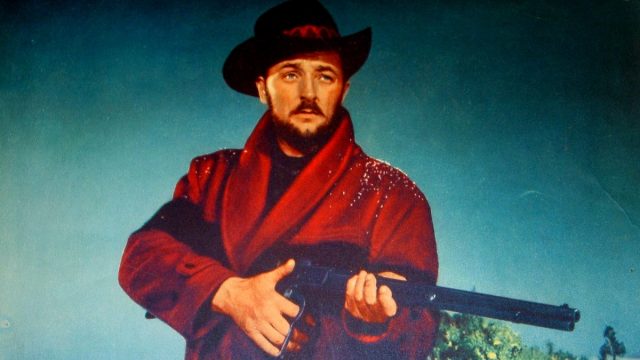Track of the Cat is an odd Western, a psychodrama that’s part dream and part dysfunctional family melodrama, like a rural Who’s Afraid of Virginia Woolf? with less claustrophobia and more panther attacks. Its shoddy structure is somewhat at odds with its intensely mannered presentation, and it could stand to lose ten or fifteen minutes of repetitive flab, but despite its faults, there’s something hypnotic about it. Perhaps it’s just that director William A. Wellman knows exactly how to make this isolated ranch feel not just emotionally claustrophobic but grasping, like a sweaty hand holding onto all the souls inside it.
There are six in the Bridges family: drunken wastrel Pa (Philip Tonge), who feels no qualms about ogling his would-be daughter-in-law; bitterly self-righteous, joyless Ma (Beulah Bondi); domineering, malicious Curt (Robert Mitchum), the sulky linchpin of it all; calm, matter-of-fact middle brother Arthur (William Hopper), who’s both saintly and doomed; passionate and desperately unhappy Grace (Teresa Wright); and baby brother Harold (Tab Hunter), who may be too weak to seize on his opportunities for happiness and escape. Also present are Gwen Williams (Diana Lynn), a spirited and levelheaded young woman who wants to marry Harold, and hired hand Joe Sam (Carl Switzer), a character cobbled together from American Indian screen clichés.
That could be a lot for a film to juggle, but Track of the Cat makes it work by taking its time–sometimes to a fault, if you can say that about a 102-minute film. The movie opens with all the Bridges boys being summoned out of bed because a “painter” (panther) is killing their livestock. They can hear the cattle lowing in alarm. They nonetheless take their time–dressing, bickering, pouring coffee, and establishing relationships in a downright leisurely while vaguely acknowledging that yeah, they should probably look into the mauling happening outside.
In a way, this bizarre lack of urgency shows the film’s priorities. This is a Western that doesn’t see any real dramatic need for the West. When it evokes its stark, wintry (and beautifully shot) landscape or its stalking panther, they’re mostly just devices to keep Robert Mitchum away from the main story for huge stretches of time. Curt is eventually trapped in a desperate struggle against the elements, but aside from one gorgeous, painful, and strikingly memorable scene involving some matches, the film mostly shrugs off his life-or-death drama. It’s more interested in what’s happening back at the farmhouse, which–thanks to sharp production design–has an imposing starkness all its own. Wellman reportedly wanted to film this like a black and white movie shot in color, and the result is a stunning, crisp visual palette, like a fairy tale woodcut occasionally interrupted by the reddest of red coats. It’s worth watching even if all you care about is the cinematography, production design, and costuming.
It’s also worth it for one of the performances. There’s a high baseline level of quality in the acting, which is deliberately theatrical, but there’s still a standout, and it’s not Mitchum but Bondi, whose Ma Bridges is the only character to feel simultaneously archetypal and poignantly, heartbreakingly human.
The story itself is spare and simple. Arthur and Curt go off to hunt the painter. The good brother dies, and the bad brother sends his body home and stays out in the wilderness to finish stalking his prey. (There’s an unexpectedly moving gesture here that manages to give the sullen Curt some genuine depth.) Meanwhile, back at the ranch, the family receives Arthur’s body and must come to terms with his death, a tragic upheaval that also acts as a catalyst re: whether or not Harold will escape with Gwen. Arthur’s death upsets the status quo, and Curt’s long absence gives everyone breathing room. With the two poles of morality out of the picture, they’re left to fumble around to fend for themselves, which they do with halting, start-and-stop effectiveness until the movie forces an unconvincing, quasi-supernatural resolution.
It mostly works on its own terms, and its biggest failing isn’t the cheat of an ending–which, to be fair, fits the film’s aesthetic if not its plot–or the intermittent slackness. It’s the way it uses its status as a Western not just as wallpaper but as a kind of early feint. Joe Sam–played by a white actor–is an embarrassment of a character, silently accepting the barrage of contempt and mockery much of the family heaps upon him, practicing a faith Arthur has to (vaguely) explain on his behalf, stalwartly enduring past tragedy, invoking omens, and finally reassuring the remaining acceptable living white guy that he’s just terrific and everything’s going to be okay now. All of this would be frustrating enough on its own, but the film makes it worse by briefly but literally suggesting that the painter is a kind of symbol of all Joe Sam’s pain. It’s a move that opens up the scope of the movie, engaging it with the world it’s depicting and suggesting some sense, however simplified, of the immense tragedy and injustice under-girding this family’s presence there.
But nah, the painter turns out to basically just be a manifestation of a white family’s own inner demons, and Joe Sam is cheerfully sure that everything will be okay now that the right white man has triumphed. It’s hard to get around the bad taste from the film playing keep-away with the notion that Native people and their lives actually matter.
Track of the Cat is streaming on the Criterion Channel.

